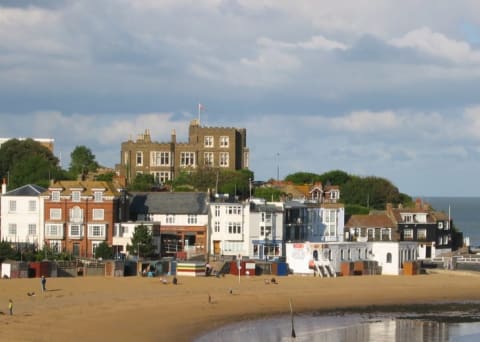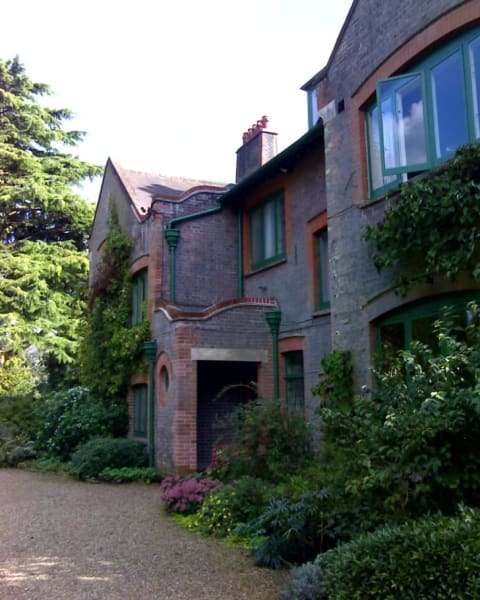15 Places You Can Visit Where Famous Works Were Written

From cafes to prisons to bathtubs, authors have written in all sorts of locations, and literature lovers today can still visit many of these sources of inspiration.
1. Pete's Tavern, New York City
Short story writer and king of the twist ending O. Henry (William Sydney Porter) reportedly penned his famous tale "The Gift of the Magi" at this old New York bar sometime between 1904 and 1906, when the place was called Healy's. A small plaque there recognizes this literary achievement and the booth where O. Henry did his writing. Although recent scholarship has indicated that the bulk of "The Gift of the Magi" was actually written at O. Henry's house across the street from Pete’s, the bar also has another literary claim to fame: Ludwig Bemelmans scribbled a first draft of his children's book Madeline at Pete's—supposedly on the back of a menu.
2. Birmingham Police Department Detention Division, Alabama
On April 16, 1963, as Dr. Martin Luther King Jr. was imprisoned in Alabama, he wrote "Letter from Birmingham Jail," in which he justified actions of civil disobedience. A year later, he revised the letter and included it in his book Why We Can't Wait. The Birmingham Civil Rights Institute later recreated King's jail cell, but the actual location was largely forgotten. In 2013, a historical marker was placed at the Birmingham Police Department Detention Division, the original location of the jail.
3. The Elephant House, Edinburgh, Scotland

There may be something magical in the tea and coffee served at The Elephant House. In the 1990s, J.K. Rowling was living in Edinburgh with her daughter, Jessica. She was just getting by on welfare and spending a lot of her time working in this cafe on her idea for a young adult novel. She titled her finished work Harry Potter and the Philosopher's Stone (changed to Sorcerer's Stone later in the U.S.). The Harry Potter books, of course, became some of the biggest bestsellers of all time. If you seek Harry Potter inspiration beyond a visit to The Elephant House, take the train from Manchester to London. Rowling has said that the idea for the boy wizard first came to her during a four-hour train delay while aboard a crowded railcar traveling this route.
4. Hotel Elysee, New York City
For the last 15 years of his life, Tennessee Williams spent much of his time at the Hotel Elysee in Manhattan. Guests often heard the clicking of his typewriter late into the night. Here he wrote The Red Devil Battery Sign and Clothes For a Summer Hotel, a portrait of F. Scott and Zelda Fitzgerald. Williams's original residence at the hotel has been split up into smaller units on the 13th floor, but guests can still enjoy a suite named in his honor. Bonus: Harold Robbins, James Michener, Mario Puzo, Leon Uris, James Clavell, and Jimmy Breslin all lived at the Elysee, as well as Marlon Brando, Joe DiMaggio, Ava Gardner, James Caan, and Sidney Poitier.
5. Broadstairs Beach, England

Broadstairs, about 80 miles east of London, is known for its seaside charm, but it was also the inspiration for the spy thriller The 39 Steps. Author John Buchan took his 6-year-old daughter, Alice, here while he was recuperating from an operation. One day in the late summer of 1914, they climbed down wooden steps to the beach. She counted aloud as they descended, shouting "39" when they set foot on the beach. Buchan was energized by the location and wrote his story while renting a house there. The steps have since been replaced, but visitors can still wander about and maybe enjoy a drink at The 39 Steps Brewhouse. Broadstairs was also a favorite holiday destination for Charles Dickens, who introduced the spot to Hans Christian Andersen and Wilkie Collins.
6. The Bastille, Paris, France
Today the site of the famous French prison from the 17th and 18th centuries is a bustling square called Place de la Bastille. Many of the king's enemies were imprisoned here, including François-Marie d'Arouet, better known as Voltaire. His crime was writing a satire about the French government. While behind bars for 11 months, he wrote the tragedy Oedipe, which became his first theatrical hit.
7. Heinold's First And Last Chance Saloon, Oakland, California

Located along the waterfront, the First and Last Chance Saloon is a watering hole where the young Jack London spent many a night. For sailors, it was the perfect spot for a last drink when shipping out or a first drink when coming ashore. According to bar lore, London wrote notes for Call of the Wild and The Sea Wolf while sitting in the saloon in the late 1800s. He mentions the bar 17 times in his novel John Barleycorn. The establishment is still pouring beers and cocktails, and maintains vestiges of the old days—gas lighting, a potbellied gas stove, and tables built from the wood of an old whaling ship.
8. Powell Library, Ucla, Los Angeles, California
Science fiction writer Ray Bradbury was a huge supporter of libraries, so it is perhaps no surprise that he wrote one of his most memorable novels, Fahrenheit 451, at Powell Library at UCLA. When he got the idea for the book in 1950, he had a young child at home and no money to rent an office. He was wandering around the campus of UCLA one day when he heard typing. He discovered that the library had a typing room in the basement, and he could rent a typewriter for 10 cents per half hour. Over 10 days, he completed his story for a cost of $9.80. (Bradbury joked that it was truly a dime novel.)
Many other authors wrote great works on college campuses: Veronica Roth started writing the Divergent series when not doing the homework in her creative writing program at Northwestern University. David Foster Wallace wrote his first novel, The Broom of the System, as an undergrad at Amherst College. Donna Tartt began her first novel, The Secret History, when she was at Bennington College.
9. Dylan Thomas's Boathouse, Laugharne, Wales

The poet and author Dylan Thomas grew up in Wales in the early part of the 20th century. In the last four years of his life, he lived with his family in a boathouse in the sleepy seaside village of Laugharne. In a shed located above the boathouse, Thomas worked on many of his writings, including "Over Sir John’s Hill," inspired by the view outside his window. Although Thomas died on a visit to New York City in 1953, he is buried on the grounds of St Martin's Church in Laugharne. The boathouse is open to the public and features a tearoom and exhibition area.
10. The Plaza Hotel, New York City
One of the most famous residents of the Plaza Hotel on Central Park is the mischievous 6-year-old Eloise, who lives on the "tippy-top floor." Kay Thompson published her first Eloise book in 1955 after having lived at the hotel. Eloise was a rebellious girl without parents, and many of Thompson's friends thought that she was very similar to Eloise. The Eloise books continue to be children's favorites to this day.
11. Café De Flore And Les Deux Magots, Paris, France

Jean-Paul Sartre and Simone de Beauvoir kept regular tables first at Café de Flore and then at Les Deux Magots in the 1940s and '50s. Sartre wrote that a typical schedule for them was to work on their writing in the café from 9 a.m. until noon. They would break for lunch, meet friends from 2 p.m. till 4, and then resume writing until 8 in the evening. In the cafés, the philosopher Sartre may have written his existentialist play No Exit, and Beauvoir may have worked on her major work of feminist philosophy, The Second Sex.
12. Agatha Christie's Tub, Devon, England
From 1938 until 1976, mystery writer Agatha Christie spent a great deal of her time at Greenway House, her estate on the River Dart in Devon, England. Under various names, Greenway was the setting for her novels Five Little Pigs, Ordeal By Innocence, and Dead Man's Folly. Christie found the bathtub an ideal place for coming up with ideas, and her tub had a special ledge to hold paper, pencils, and apples. (Christie enjoyed eating apples perhaps as much as her character Ariadne Oliver, who was a friend to detective Hercule Poirot.) Now owned by The National Trust in England, Greenway is open for tours.
13. George Bernard Shaw's Revolving Writing Hut, Ayot St. Lawrence, England

For 40 years starting in 1906, George Bernard Shaw produced the majority of his plays in a shed he built on a rotating platform so it could be turned to follow the sun as he worked during the day. The writing hut is part of his estate, called Shaw’s Corner and located in the English countryside. The small structure was equipped with an electric heater, typewriter, and a bunk for napping. Shaw dubbed the space London so if he wanted to avoid callers, they were told, "Sorry, Mr. Shaw is in London at the moment." Shaw's Corner is part of The National Trust and open to the public.
14. The Famous Tree At The D.H. Lawrence Ranch, New Mexico
D.H. Lawrence wrote many of his novels and short stories sitting under a tree, wherever he was in the world. He found a favorite tree on a ranch in north New Mexico near Taos. His wife, Frieda, had acquired the property in exchange for the manuscript for Sons and Lovers. Underneath this towering ponderosa pine, Lawrence spent many mornings in the 1920s putting pen to paper. "One goes out of the door and the tree-trunk is there, like a guardian angel," he wrote. Here he produced St. Mawr and part of The Plumed Serpent. Georgia O'Keeffe captured the magic of the tree in her painting The Lawrence Tree. Today, visitors are welcome to come see the ranch and take inspiration from the majestic pine.
15. 400 East 59th Street, New York City
From the mid-1940s until 1951, the short story author and novelist John Cheever lived with his family at 400 East 59th Street, near Sutton Place in Manhattan. Cheever had a very productive period at this location, writing much of his novel The Holly Tree (which eventually become The Wapshot Chronicle) and several short stories, including "The Enormous Radio," about a radio that allows the owners to listen in on private conversations in an apartment building.
His writing routine there was memorable. In the morning, he would dress in his suit and join the other businessmen heading off to work. Cheever, however, would stay in the elevator when the others got off in the lobby. He continued on to the basement where he used a maid's room for writing. He took off his suit down to his boxers and wrote. When he finished for the day, the suit went back on and he returned home upstairs. While it’s probably difficult to visit the basement where Cheever wrote, you can certainly walk by the building and pay tribute to one of America's great authors.
This list first ran in 2016.